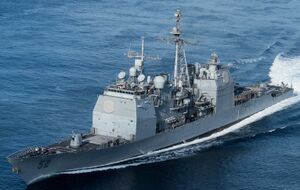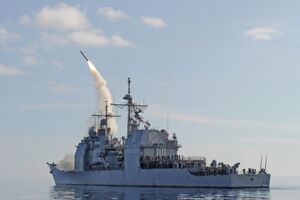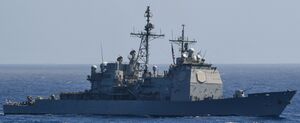Salsu-class guided-missile cruiser
 KHMS Salsu
| |
| Class overview | |
|---|---|
| Name: | Salsu class |
| Builders: | Hyundai Heavy Industries Co.,Ltd. |
| Operators: |
|
| Preceded by: | Guiju-class |
| Succeeded by: | Myeongnyang-class |
| Cost: | $1 Billion |
| Built: | 1999-2009 |
| In commission: | 2001–present |
| Planned: | 12 |
| Completed: | 10 |
| Cancelled: | 2 |
| Active: | 10 |
| Lost: | 0 |
| General characteristics | |
| Type: | Guided-missile cruiser |
| Displacement: | 9,800 t full load |
| Length: | 173 m |
| Beam: | 16.8 m |
| Draft: | 10.2 m |
| Propulsion: | |
| Speed: | 32.5 knots (60 km/h; 37.4 mph) |
| Range: | 6,000 nmi (11,000 km) |
| Sensors and processing systems: |
|
| Electronic warfare & decoys: | LIG Nex1 SLQ-200K Sonata electronic warfare suite |
| Armament: |
|
| Aircraft carried: | 2 × Anti-Submarine helicopters |
The Salsu-class guided-missile cruiser is a cruiser operated by Royal Joseon Navy. It was constructed from 1999 to 2009, 8 of which are still active. Salsu-class is also the Royal Joseon Navy's first Mabangjin system-equipped vessel.
The Salsu-class cruiser was designed and constructed to counter Svetvostok's naval modernization plans and the construction of large air defense combat ships.
History
Throughout the 1990s and 2000s, Svetvostok intensively reinforced its outdated naval capabilities and enhanced its operational capabilities in the distant oceans. The Kanin-class destroyer and the Lim Se-Kyung class cruiser were built as part of these initiatives and greatly enhanced Svetvostok's naval capabilities. With conflicts with Svetvostok existing due to historical and territorial issues, Joseon considered it a dangerous situation for Svetvostok to close the naval power gap with Joseon. In response, Joseon designed new ships and initiated a modernization project to strengthen the quality of naval power.
However, the naval modernization project took time, and Svetvostok built a series of new large ships. This raised the need for urgent shipbuilding to fill the void in the ongoing naval modernization project. At the time, the Mabangjin system was completed and its performance was verified, so the Navy and Agency for Defense Development(ADD) designed a gap-filler cruiser using the hull of the Yang-Gyu class destroyer they were using.
Salsu-class contributed significantly to Joseon's naval power as the only Mabangjin system-equipped ship owned by the Royal Joseon Navy until the advent of Sejong the Great-class destroyer. However, because Salsu-class kept the Yang-Gyu class design intact, it also brought about the chronic problem of instability in the hull balance.
Description
Salsu-class modeled after the Yang-Gyu class in almost every way. Salsu-class has the capability to sail in any sea, and it has the capability to perform multiple operations in all kinds of seas. However, some ships navigating through rough seas have reported superstructure cracks due to the weight of the superstructure. The Navy is addressing this issue by regularly inspecting and repairing the superstructure.
Salsu-class is the first Aegis system-equipped ship owned by the Royal Joseon Navy, with strong air defense capabilities and ballistic missile defense capabilities. Using AN/APY-1B radar, Salsu-class can track 900 targets simultaneously, and engage with 20 of them simultaneously.
Salsu-class operates various types of missiles, equipped with a total of 128 Mk.41 VLS cells. Since the Mk.41 VLS of the Yang-Gyu class has 2 reloading cranes that take up space for a total of 6 VLS cells, the number of Mk.41 VLS cells of the Ticonderoga-class is 122. However, using reloading cranes in waters shaken by waves is considered very difficult. Because of this, Salsu-class does not have reload cranes and instead has 6 additional VLS cells to operate more weapons.

